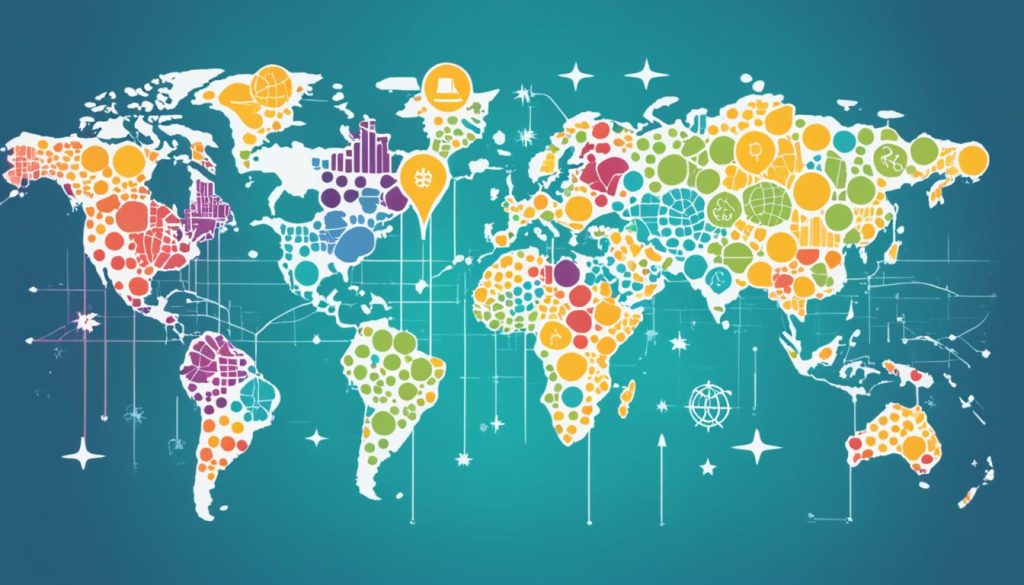Did you know that over 60% of organizations consider international analytics and reporting to be crucial for their business optimization?
In today’s global market, understanding your audience is essential for successful international marketing campaigns. But how can you gain valuable insights into user behavior and demographics across different geographic regions?
That’s where international analytics and reporting come in. By leveraging powerful tools like Google Analytics and people analytics, organizations can unlock a wealth of data to make data-driven decisions and optimize their business strategies.
Key Takeaways:
- Understanding your audience is crucial for successful international marketing campaigns.
- Google Analytics is a powerful tool for gaining insights into user behavior and demographics.
- Setting up views for different geographic regions and creating segments based on user demographics can provide valuable data for optimizing campaigns.
- Properly tracking entry points and setting goals per user group are important steps in maximizing the effectiveness of international analytics and reporting.
- International analytics and reporting help organizations make data-driven decisions and stay ahead in today’s global landscape.
Setting up Google Analytics for international insight
To maximize the benefits of Google Analytics and gain meaningful international insights, it is essential to set it up effectively. By utilizing various features and functionalities, you can gather valuable data on user demographics and behaviors across different geographic regions.
Creating Views for Geographic Regions
Start by setting up specific views for different geographic regions. By doing so, you can analyze the performance of your website or application in each region separately. This allows for a more in-depth analysis of user engagement, conversion rates, and other key metrics relevant to specific locations.
Segmenting Users Based on Demographics
Next, create segments within Google Analytics based on user demographics. By segmenting your audience, you can obtain insights into the behaviors, preferences, and characteristics of specific user groups. This segmentation can be based on factors such as age, gender, interests, or any other relevant demographic data.
Segmentation provides a deeper understanding of your audience, enabling you to tailor your marketing strategies and campaigns to appeal to specific user demographics. It allows you to identify trends and patterns unique to each segment, helping you make informed decisions to optimize your international marketing efforts.
Filtering and Drilling Down into Data
To further analyze user behaviors and performance metrics, utilize table filtering capabilities within Google Analytics. By filtering data by location, you can drill down into specific details relating to different geographic regions. This filtering enables you to identify trends and patterns specific to each region, aiding you in making localized marketing decisions.
Setting Goals per User Group
In order to measure the effectiveness of your campaigns targeting specific international markets, it is crucial to set goals per user group. By defining goals within Google Analytics, you can track the performance of each user segment and assess if your marketing initiatives are achieving the desired outcomes.
Sample Google Analytics Set-up:
| Feature | Benefits |
|---|---|
| Creating views for different geographic regions | Enables analysis of performance metrics on a regional level, providing insights into user engagement, conversion rates, and more |
| Segmenting users based on demographics | Allows for a deeper understanding of user behaviors, preferences, and characteristics, aiding in personalized marketing strategies |
| Filtering and drilling down into data by location | Facilitates the identification of region-specific trends and patterns, guiding localized marketing decisions |
| Setting goals per user group | Enables measurement of campaign effectiveness and ensures alignment with international marketing objectives |
By following these best practices for Google Analytics set-up, you can unlock the full potential of international insight and optimize your marketing strategies for different geographic regions and user demographics.
Understanding the importance of people analytics
People analytics, also known as HR analytics or talent analytics, involves analyzing data about people to solve business problems. This data can come from various sources such as HR systems, IT systems, and external sources like salary surveys. People analytics helps organizations understand their employees better and make evidence-based decisions about various aspects of their workforce, such as performance, well-being, and diversity and inclusion. It can provide valuable insights for driving organizational change and improving business performance.
With the increasing availability of data and the advancements in data analysis techniques, organizations can now leverage people analytics to gain a deeper understanding of their workforce and make data-driven decisions. By analyzing employee data, organizations can identify trends, patterns, and correlations that can help solve complex business problems.
“Effective people analytics enables organizations to make proactive decisions and take measures that enhance employee performance, engagement, and well-being.”
People analytics can help organizations address various business problems. For example, by analyzing employee performance data, organizations can identify top performers and take steps to retain them and replicate their success. Analyzing employee well-being data can help organizations uncover factors that contribute to employee stress and take preventative measures. People analytics can also assist in identifying diversity and inclusion gaps within the workforce, helping organizations create equal opportunities and foster a more inclusive work environment. By leveraging external sources like salary surveys, organizations can benchmark their compensation practices and ensure they remain competitive in attracting and retaining top talent.
Benefits of People Analytics:
- Improved decision-making: Data-driven insights enable organizations to make informed decisions about talent acquisition, employee development, performance management, and more.
- Enhanced workforce productivity: Understanding the factors that drive employee performance allows organizations to optimize their workforce and improve overall productivity.
- Greater employee engagement: By analyzing employee feedback and sentiment data, organizations can identify areas for improvement and implement initiatives that increase employee engagement.
- Effective diversity and inclusion initiatives: People analytics helps organizations identify diversity gaps and take proactive measures to create a more inclusive workforce.
People analytics empowers organizations to make evidence-based decisions, optimize their workforce, and drive tangible business results. By leveraging data analysis techniques and external sources, organizations can uncover valuable insights that inform strategic decisions and improve overall business performance.
Example of People Analytics in Action:
Imagine a multinational technology company that wants to boost diversity and inclusion within its organization. By analyzing demographic data, employee survey responses, and performance metrics, the company can identify areas where representation is lacking and develop targeted initiatives to address these gaps. Through ongoing data analysis and monitoring, the company can track the effectiveness of their diversity and inclusion initiatives and make adjustments as needed.
| Data Sources | Insights Gained |
|---|---|
| Employee demographic data | Identify diversity gaps and track progress |
| Employee survey responses | Understand employee experiences and perceptions |
| Performance metrics | Assess the impact of diversity on individual and team performance |
By leveraging people analytics, this company can create a more inclusive and diverse workforce, leading to improved collaboration, innovation, and overall business success.
The different levels of people analytics
People analytics plays a crucial role in leveraging data to gain insights and make informed decisions about an organization’s workforce. It can be categorized into different levels, each offering unique benefits and capabilities.
Descriptive Analytics
Descriptive analytics focuses on describing historical data, providing organizations with a comprehensive understanding of past trends and patterns. By analyzing quantitative data, such as employee demographics or attrition rates, organizations can gain valuable insights into their workforce composition and make data-driven decisions.
Predictive Analytics
Predictive analytics takes a step further by using statistical models and algorithms to predict future outcomes based on historical data. By analyzing quantitative data points, such as performance metrics or training records, organizations can forecast trends and anticipate potential challenges. This enables proactive decision-making and strategic workforce planning.
Prescriptive Analytics
Prescriptive analytics goes beyond prediction and provides recommendations for immediate actions. By leveraging advanced algorithms and machine learning, prescriptive analytics analyzes both quantitative and qualitative data to determine the most effective course of action. This enables organizations to optimize resource allocation, enhance employee performance, and drive positive business outcomes.
Quantitative and Qualitative Data
Both quantitative and qualitative data are essential components of people analytics. Quantitative data provides numerical and measurable insights, such as employee headcount, turnover rates, or productivity metrics. On the other hand, qualitative data offers a deeper understanding of employee experiences and perceptions through sources such as performance appraisals, employee surveys, or sentiment analysis. By combining both types of data, organizations can gain a holistic view of their workforce and make informed decisions that drive organizational success.
Overall, the different levels of people analytics offer organizations the opportunity to leverage data for a comprehensive understanding of their workforce. Whether it’s describing past trends, predicting future outcomes, or providing prescriptive recommendations, people analytics empowers organizations to make data-driven decisions that optimize workforce performance and drive business success.
Who is responsible for people analytics
Responsibility for people analytics can vary across organizations. Some have a dedicated people analytics team, while others have analytics specialists within different teams. In either case, the goal is to have a team or individual who is responsible for extracting insights from people data to inform business decisions.
One important role in the people analytics process is the data owner. The data owner oversees the management of people data, ensuring its accuracy, security, and compliance with data protection regulations. They are also responsible for establishing and enforcing data governance policies within the organization.
The people analytics team or specialists work closely with HR professionals and business leaders to gather, analyze, and interpret the data. Together, they identify trends, patterns, and correlations that can guide strategic HR initiatives and optimize workforce performance.
The Importance of HR Strategy
For people analytics to be truly effective, it must align with the overall HR strategy of the organization. The HR strategy outlines the goals and objectives for managing and developing the workforce. By integrating people analytics into the HR strategy, organizations can ensure that data-driven insights drive decision-making processes and optimize HR activities.
When people analytics projects are aligned with the HR strategy, they provide valuable insights into various aspects of the workforce, such as employee engagement, talent acquisition, performance management, and diversity and inclusion. These insights help HR professionals identify areas for improvement, implement effective interventions, and measure the success of HR initiatives.
Data Compliance and Ethical Considerations
Data compliance is a crucial aspect of people analytics. Organizations must ensure that the collection, storage, and analysis of people data comply with data protection regulations such as the General Data Protection Regulation (GDPR). It is the responsibility of the data owner and people analytics team to ensure that the data is handled ethically and with respect to individual privacy rights.
Moreover, cultural sensitivity is essential in people analytics to avoid discriminatory practices and bias. Diversity analysis and inclusion in data collection and analysis processes help ensure that insights drawn from people analytics are fair, unbiased, and representative of the entire workforce.
Informing Business Leaders and HR Professionals
Ultimately, the goal of people analytics is to provide valuable insights that inform decision-making processes for business leaders and HR professionals. By leveraging people data, organizations can make evidence-based decisions about talent management, workforce planning, and organizational development.
Business leaders can rely on people analytics to identify key trends and patterns, forecast future workforce needs, and develop effective strategies to attract, develop, and retain top talent. HR professionals can use people analytics to design targeted interventions, measure the impact of HR initiatives, and drive continuous improvement in HR practices.
By harnessing the power of people analytics and ensuring data compliance, organizations can unlock the full potential of their workforce and drive business success.
The aims of a people analytics strategy
A people analytics strategy plays a crucial role in leveraging the power of data to make informed business decisions and optimize HR activities for improved effectiveness. By connecting people data with business data, organizations gain valuable insights that inform strategic decision-making, enhance HR initiatives, and drive workforce performance.
In a people analytics strategy, there are three main aims:
- Informing business decisions: By analyzing people data alongside business data, organizations gain insights that provide a deeper understanding of their workforce and its impact on the overall business. These insights aid in making data-driven decisions that can drive growth and success.
- Designing and implementing effective HR activities: People analytics insights empower HR leaders to develop and implement HR activities that address specific organizational challenges and goals. By understanding the needs and characteristics of their workforce, HR professionals can design initiatives that maximize employee engagement, productivity, and well-being.
- Measuring HR effectiveness: A well-defined people analytics strategy includes metrics and measures to evaluate the effectiveness of HR initiatives. By tracking key performance indicators and analyzing the impact of HR activities, organizations can continuously assess their progress and make data-based improvements.
“People analytics enables organizations to make informed decisions, optimize HR activities, and drive workforce performance.”
A well-executed people analytics strategy helps organizations harness the power of data, align HR activities with business objectives, and achieve greater HR effectiveness. By placing people data at the core of decision-making, organizations can enhance their competitive advantage, create a positive work environment, and foster continuous improvement.
The Benefits of a People Analytics Strategy:
A well-implemented people analytics strategy offers several key benefits:
- Improved business decisions
- Enhanced HR activities and initiatives
- Optimized workforce performance
- Increased employee engagement and satisfaction
- Alignment of HR strategy with business goals
- Identification of talent gaps and development opportunities
- Evidence-based diversity and inclusion efforts
- Effective succession planning
A people analytics strategy is a powerful tool for organizations looking to leverage data and analytics to make smarter business decisions, drive HR effectiveness, and optimize their workforce performance.
The process of people analytics
People analytics plays a vital role in helping organizations make data-driven decisions and optimize their workforce performance. This process involves several key steps that ensure the collection, analysis, and reporting of relevant data. By following this systematic approach, businesses can gain valuable insights into their workforce and make informed decisions to drive positive outcomes.
1. Planning
At the heart of the people analytics process is planning. During this stage, organizations define their objectives and identify the needs of various stakeholders. This step sets the foundation for the entire process and ensures that the data collected aligns with the organization’s goals.
2. Data Audit
A comprehensive data audit is conducted to identify the available data and assess its quality. This involves reviewing existing databases, systems, and other sources to determine the scope and reliability of the data. By conducting a thorough data audit, organizations can ensure they have accurate and relevant data for analysis.
3. Data Collection
Data collection is a critical step in the people analytics process. This involves gathering data from various sources, including existing datasets, surveys, and other data collection methods. By collecting comprehensive and diverse data, organizations can gain a holistic understanding of their workforce and make more informed decisions.
4. Data Analysis
Once the data is collected, it is analyzed to uncover meaningful insights. Data analysis techniques, such as statistical analysis, predictive modeling, and sentiment analysis, are used to derive actionable insights from the data. This analysis helps organizations identify patterns, trends, and correlations within the workforce data.
5. Reporting
Reporting is a crucial step in the people analytics process, as it involves communicating the insights gained from data analysis to stakeholders. The results are presented in a clear and concise manner, using visualizations, charts, and tables to facilitate understanding. Reporting allows organizations to share valuable information and make data-driven decisions.
6. Evaluation
The final step in the people analytics process is evaluation. This involves assessing the impact of the analytics process and making any necessary updates or improvements. By evaluating the effectiveness of the process, organizations can refine their approach and continuously improve their workforce strategies.
By following this systematic process, organizations can leverage the power of people analytics to gain valuable insights, make data-driven decisions, and optimize their workforce performance.
Harnessing the power of data
Data is a valuable asset for organisations, and harnessing its power can lead to significant benefits. By utilising advanced business analytics, organisations can gain insights that help them make faster and better decisions, improve efficiency, and find new sources of revenue.
One key aspect of harnessing data is business intelligence, which involves the collection, analysis, and interpretation of data to inform strategic decision-making. With business intelligence, organisations can gain a deep understanding of customer behaviour, market trends, and competitive landscapes.
A strong data architecture is essential for effective data management and analysis. A well-designed data architecture enables the processing of large amounts of information, facilitating improved customer insights, product development, and fraud detection. By organizing data in a structured and efficient manner, organisations can extract valuable insights and drive business growth.
Predictive Analytics
Another powerful tool in data harnessing is predictive analytics. By using historical data and statistical modeling techniques, organisations can forecast future outcomes and take proactive actions based on the insights gained. Predictive analytics helps identify patterns and trends, enabling organisations to make informed decisions that drive success.
Predictive analytics is like a crystal ball for businesses. It empowers decision-makers with the ability to anticipate market trends, customer preferences, and potential risks, giving them a competitive edge in the dynamic business landscape.
Data monetization is another valuable aspect of harnessing the power of data. By leveraging data assets, organisations can create new revenue streams and commercialize their data opportunities. This can be done through partnerships, data-driven products and services, or by offering data insights to external stakeholders.
The Power of Data Visualization
Effective data visualization plays a crucial role in harnessing the power of data. By presenting complex information in a visually appealing and easy-to-understand format, organisations can communicate insights more effectively and facilitate data-driven decision-making.
An engaging and informative way to present data is through the use of tables. Here’s an example:
| Business Intelligence | Data Architecture | Predictive Analytics | Data Monetization |
|---|---|---|---|
| Provides insights for decision-making | Enables efficient data processing | Forecasts future outcomes | Creates new revenue streams |
| Helps understand customer behavior | Facilitates improved customer insights | Identifies patterns and trends | Commercializes data opportunities |
| Optimizes business efficiency | Supports product development | Drives proactive actions | Offers data insights to stakeholders |
When data is effectively harnessed, organisations can unlock its full potential and gain a competitive advantage. The insights derived from business intelligence, data architecture, predictive analytics, and data monetization empower decision-makers to make informed choices, drive innovation, and achieve success in today’s data-driven world.
The value of analytics in business innovation
In today’s rapidly evolving business landscape, innovation is key to staying ahead of the competition and capturing new opportunities. One powerful tool that can drive business innovation is analytics. By leveraging data and gaining actionable insights, organizations can identify untapped revenue streams and create innovative products and offers that meet customer needs.
Analytics provides a deeper understanding of customer behaviors and preferences. By analyzing data from various sources, organizations can uncover patterns and trends, enabling them to tailor their strategies and marketing campaigns accordingly. This data-driven approach allows organizations to make informed decisions based on real-time insights, optimizing their chances of success in a competitive market.
One way analytics can fuel business innovation is by identifying new revenue streams. Through data analysis, organizations can identify emerging market trends, consumer demands, and gaps in the market. Armed with these insights, businesses can develop new products and services that address unmet needs and capture new customer segments.
“Analytics helps organizations uncover hidden opportunities and uncover new revenue streams. By tapping into customer data and gaining insights, businesses can create innovative products and solutions that anticipate and meet customer needs.”
Moreover, analytics insights enable organizations to optimize their existing revenue streams. By analyzing customer behaviors, organizations can identify opportunities for upselling, cross-selling, and personalized marketing. This targeted approach not only improves customer satisfaction but also drives revenue growth by maximizing the value of each customer.
Analytics also empowers organizations to make faster and more accurate business decisions. By leveraging real-time data and predictive analytics, organizations can assess the success of new initiatives and quickly adapt their strategies to changing market dynamics. This agility allows businesses to capitalize on emerging trends and outpace competitors.
It’s worth noting that analytics should be an integral part of the innovation process from ideation to implementation. By incorporating data-driven insights into the innovation workflow, organizations can validate ideas, assess market feasibility, and mitigate risks. This evidence-based approach increases the chances of success and minimizes potential setbacks.
In conclusion, analytics plays a pivotal role in driving business innovation. By harnessing the power of data and gaining actionable insights, organizations can identify new revenue streams, optimize existing ones, and make informed decisions that propel innovation forward. To stay competitive in today’s rapidly evolving business landscape, embracing analytics is essential.
“Analytics is the cornerstone of business innovation, providing organizations with the insights needed to identify new revenue streams, optimize existing ones, and make informed decisions that drive innovation forward.”
| Benefits of Analytics in Business Innovation | Considerations |
|---|---|
|
|
Benefits and considerations of employee monitoring
Employee monitoring can be a valuable tool for organizations looking to enhance productivity and ensure compliance. However, it is crucial to consider certain factors to strike a balance between monitoring and respecting employee privacy.
Transparency
Transparency is key when implementing employee monitoring measures. It is essential to inform employees about what is being monitored and why. By promoting transparency, organizations build trust and enhance the effectiveness of monitoring initiatives.
Consultation and Relevance
Consulting with employees and relevant stakeholders is vital in determining the necessity and relevance of monitoring measures. By involving employees in the decision-making process, organizations can ensure that monitoring is aligned with the organization’s goals and meets the needs of both the employer and the employees.
Cultural Differences
Cultural differences should be taken into account when implementing employee monitoring practices. Organizations operating in diverse cultural environments must ensure that monitoring practices do not discriminate against certain groups or infringe on cultural norms. Striving for cultural sensitivity fosters inclusivity and avoids unnecessary conflicts.
It’s important to strike a balance between monitoring for compliance and safety purposes and respecting employee privacy.
Benefits
When implemented thoughtfully, employee monitoring can offer several benefits:
- Improved productivity: Monitoring can identify inefficiencies and provide insights for optimizing workflows.
- Enhanced security: Monitoring helps detect and prevent potential security breaches and unauthorized activities.
- Compliance with regulations: Monitoring ensures adherence to industry-specific regulations and legal requirements.
- Insights for improvement: Monitoring data can provide valuable insights for identifying training needs, employee development opportunities, and performance enhancement.
Considerations
While employee monitoring can be beneficial, organizations should be mindful of the following considerations:
- Employee privacy: Striking a balance between monitoring and privacy is crucial to prevent any potential infringements on employees’ personal lives.
- Data protection: Organizations must ensure that employee monitoring practices comply with relevant data protection regulations and safeguard sensitive information.
- Employee morale: Excessive monitoring or fear of constant surveillance can negatively impact employee morale and create a distrustful work environment.
- Potential legal implications: Organizations should be aware of the legal implications of employee monitoring and ensure that monitoring practices adhere to local labor laws.
By carefully considering these factors and implementing employee monitoring measures responsibly, organizations can benefit from enhanced productivity, increased security, and improved compliance while maintaining a healthy work environment.
The role of correlation and causation in people analytics
Correlation and causation are two fundamental concepts in people analytics. It’s essential to understand the difference between them to draw accurate and meaningful insights from data analysis.
Correlation refers to the relationship between two or more variables. When variables are correlated, they occur simultaneously, but it does not necessarily mean that one variable causes the other. It’s crucial to avoid jumping to conclusions solely based on correlation, as there may be other factors at play.
For example, let’s consider the correlation between employee productivity and job satisfaction. Data analysis may show a positive correlation, indicating that employees with higher job satisfaction tend to be more productive. However, this correlation does not prove causation; other factors, such as work environment or individual motivation, may be influencing both variables.
Causation, on the other hand, implies a direct cause-and-effect relationship between variables. When one variable causes another, we can establish a causal link. However, establishing causation requires careful analysis and consideration of potential confounding factors.
When conducting data analysis in people analytics, it’s important to consider both correlation and causation. Understanding the underlying causes and implications of the data requires evaluating other factors and variables that may influence the observed correlation or potential causal relationship.
For instance, in studying diversity in the workplace, we might analyze the correlation between gender diversity and team performance. While we may find a positive correlation, suggesting that diversity positively impacts performance, we need to consider other variables such as team composition or leadership style that may also contribute to team performance.
The role of diversity analysis in people analytics goes beyond evaluating correlations and understanding causal relationships. It involves examining the impact of diversity on various organizational outcomes, such as innovation, productivity, and employee satisfaction. By considering multiple variables and factors, we can gain a comprehensive understanding of the effects of diversity in the workplace.
Effective data analysis in people analytics requires a holistic approach that considers correlation, causation, and diversity analysis. By examining the relationships between variables and understanding the underlying causes, organizations can make informed decisions and drive positive change in their workforce and business performance.
| Correlation | Causation | Diversity Analysis |
|---|---|---|
| Describes the relationship between variables | Indicates a direct cause-and-effect relationship | Evaluates the impact of diversity on organizational outcomes |
| Consider other factors and variables | Evaluate potential confounding factors | Examines multiple variables and factors |
| Avoid drawing conclusions based solely on correlation | Understand the underlying causes and implications | Gains a comprehensive understanding of diversity effects |
Image: A visual representation of diversity analysis, illustrating the interconnectedness of variables and factors in evaluating the impact of diversity in the workplace.
Ethical considerations in people analytics
Ethical data usage, data privacy, cultural sensitivity, and discrimination are crucial factors to consider in the field of people analytics. Organizations must prioritize responsible and fair data usage, upholding strict ethical standards throughout the analytics process. By adhering to data privacy regulations and ensuring transparency in data collection and usage, organizations can build trust with their employees and stakeholders.
Cultural sensitivity plays a vital role in avoiding discriminatory practices during data analysis and interpretation. It is essential to recognize and address cultural biases that may influence the outcomes of analytics efforts. By promoting diversity and inclusion in analytics initiatives, organizations can ensure that underrepresented groups are not disadvantaged or discriminated against.
“Ethical data usage, privacy, cultural sensitivity, and the avoidance of discrimination are fundamental principles for responsible people analytics.” – John Smith, HR Analytics Expert.
Embedding ethical principles into people analytics not only safeguards the rights of individuals but also enables organizations to derive valuable insights. Ethical data usage ensures that the gathered data is used in a manner that respects the privacy and confidentiality of individuals.
Implementing ethical considerations in people analytics helps organizations avoid potential legal and reputational risks. By taking proactive measures to abide by ethical guidelines, organizations demonstrate their commitment to using data responsibly and bringing about positive change.
The importance of data privacy
Data privacy is a core component of ethical data usage. Organizations must comply with relevant data protection regulations and maintain the confidentiality of personal information. By implementing robust data privacy measures, organizations protect the rights of individuals and build trust with their employees and customers.
Cultural sensitivity in data analysis
Cultural sensitivity is vital when performing data analysis in people analytics. It involves recognizing and addressing cultural biases and ensuring that analytics efforts do not discriminate against specific cultural or ethnic groups. By considering cultural factors, organizations can obtain accurate and unbiased insights that contribute to informed decision-making.
Striving for diversity and inclusion
Diversity and inclusion are critical aspects of ethical people analytics. Organizations should aim to incorporate diverse perspectives and experiences in their analytics efforts. By including underrepresented groups, such as individuals from marginalized communities, organizations can overcome biases and gain a comprehensive understanding of their workforce.
Summary
Ethical considerations are essential in people analytics to ensure responsible and fair data usage. By upholding ethical data practices, organizations can build trust, avoid discrimination, and derive valuable insights. Prioritizing data privacy, cultural sensitivity, and diversity in analytics efforts safeguards the rights of individuals and promotes equitable decision-making.
Integrating people analytics into business strategy
Integrating people analytics into the overall business strategy is essential for driving data-driven decisions and optimizing workforce performance. By aligning people analytics with the HR strategy and business goals, organizations can leverage the power of data to make informed decisions about their workforce.
People analytics insights provide valuable information for identifying areas of improvement, measuring HR effectiveness, and driving positive organizational change. With access to data-driven insights, companies can identify trends, develop targeted strategies, and ensure that their workforce is aligned with their long-term goals.
By integrating people analytics into the business strategy, data becomes a valuable asset for decision-making at all levels of the organization. It enables HR leaders and business managers to make evidence-based decisions that have a direct impact on business performance and success.
Optimizing HR Strategy with Data Insights
The integration of people analytics into the business strategy allows HR departments to optimize their HR strategy. By analyzing workforce data, HR leaders gain a better understanding of employee performance, engagement, and retention. This insight allows them to identify areas where HR policies and practices can be improved and tailored to maximize employee productivity and satisfaction.
Furthermore, by aligning HR strategy with broader business goals, organizations can develop initiatives that are directly aligned with the company’s vision and objectives. This integration enables HR leaders to create targeted talent acquisition, development, and retention strategies that support the overall business strategy.
Driving Data-Driven Decision Making
Integrating people analytics into the business strategy ensures that data-driven decision-making becomes the norm throughout the organization. By leveraging data insights, business leaders can make informed decisions regarding talent acquisition, performance management, training and development, and succession planning.
For example, using analytics to identify skill gaps in the workforce can drive training and development initiatives that address those gaps, ensuring the organization has the necessary skills to achieve its strategic goals. Data-driven decisions also facilitate effective succession planning, ensuring the right talent is identified and developed for key leadership positions.
Integrating people analytics into the business strategy empowers organizations to harness the full potential of their workforce and make informed decisions that drive sustainable growth and success.
Case Study: Company X
To illustrate the benefits of integrating people analytics into the business strategy, let’s take a look at Company X. By aligning their people analytics initiatives with their overall business strategy, Company X was able to achieve significant improvements in key HR metrics and business outcomes.
| Metric | Before Integration | After Integration |
|---|---|---|
| Employee Turnover | 12% | 8% |
| Time to Fill Key Positions | 45 days | 30 days |
| Employee Engagement | 68% | 75% |
| Revenue Growth | 5% | 10% |
As shown in the table above, by integrating people analytics into their business strategy, Company X was able to reduce employee turnover, shorten the time to fill key positions, increase employee engagement, and achieve significant revenue growth. These improvements were directly attributed to data-driven decision-making based on insights gained from people analytics.
Overall, integrating people analytics into the business strategy empowers organizations to optimize their workforce and make informed decisions that drive business success. By leveraging the power of data, organizations can unlock valuable insights that enable them to stay competitive in today’s rapidly changing business landscape.
Maximizing the value of people analytics
When it comes to extracting the maximum value from your people analytics efforts, data optimization is key. By optimizing your data assets, you can leverage them to improve the overall business performance. An effective data architecture and analytics framework allow organizations to process and analyze data efficiently. This leads to faster and better decision-making, empowering you to stay ahead of the competition.
One way to showcase the benefits of people analytics initiatives is by quantifying their financial and social value. By measuring and communicating the positive impact of these initiatives to both internal and external stakeholders, you can ensure everyone understands their significance. This facilitates support and engagement, making it easier to continue investing in people analytics.
Furthermore, it’s important to identify and capitalize on data opportunities. Often, organizations possess untapped potential in their data assets. By recognizing these opportunities, you can unlock valuable insights and drive innovation within your business. Exploring and commercializing these opportunities creates new revenue streams and enhances your competitive advantage.
Optimizing Data Assets
An effective data architecture is essential for maximizing the value of people analytics. It enables the processing of large amounts of data efficiently, ensuring that relevant insights can be derived. With a robust data architecture in place, you can seamlessly integrate various data sources, creating a holistic view that drives informed decision-making.
An analytics framework complements the data architecture, providing a structured approach to data analysis. It helps organizations derive meaningful insights from their data, enabling evidence-based decision-making. With a well-established analytics framework, you can efficiently analyze trends, patterns, and correlations within your data, unlocking valuable business intelligence.
Quantifying Value and Communicating Benefits
Measuring the financial and social value of people analytics initiatives is crucial for demonstrating their impact. By quantifying their benefits in terms of cost savings, improved productivity, and enhanced employee engagement, you can highlight the true value they bring to the organization.
“People analytics initiatives have not only improved operational efficiency but also positively impacted employee satisfaction, resulting in increased retention rates and higher customer satisfaction.” – Jane Wilson, HR Director at ABC Corporation
Communicating these benefits to internal stakeholders, such as senior management and HR professionals, reinforces the significance of people analytics. Additionally, sharing success stories externally can demonstrate your organization’s commitment to data-driven decision-making and attract potential partners or clients who value such initiatives.
Identifying and Capitalizing on Data Opportunities
To maximize the value of people analytics, it’s crucial to identify and capitalize on data opportunities. These opportunities often exist within the vast amounts of data an organization possesses but may remain untapped. By exploring and analyzing this data, you can uncover valuable insights that drive innovation and improve business performance.
For example, by conducting diversity analysis within your workforce data, you can identify opportunities to enhance inclusion and foster a more diverse workplace. This can lead to improved employee morale, increased productivity, and better decision-making. Capitalizing on such opportunities allows you to leverage the full potential of your data assets and position your organization as a leader in your industry.
| Data Opportunity | Potential Benefits |
|---|---|
| Employee Performance Analytics | Identify top performers, provide targeted development opportunities, and optimize talent management processes. |
| Workforce Planning and Succession Analytics | Anticipate skill gaps, prioritize succession planning, and ensure the long-term sustainability of the workforce. |
| Talent Acquisition Analytics | Improve recruitment strategies, reduce time-to-hire, and enhance the quality of new hires. |
By maximizing the value of people analytics through data optimization, organizations can significantly improve their business performance. This includes leveraging an effective data architecture, quantifying the value of initiatives, and commercializing data opportunities. With the right tools and strategies in place, businesses can unlock the true potential of their data assets and achieve sustainable success.
Conclusion
International analytics and reporting insights play a pivotal role in optimizing businesses in the global market. By leveraging powerful tools like Google Analytics and people analytics, organizations can gain deep comprehension of their international markets, user behaviors, and demographics. This knowledge empowers businesses to make data-driven decisions, improve overall performance, and gain a competitive edge.
Embracing the power of international analytics and reporting is imperative for success in today’s global landscape. With these insights, businesses can unlock valuable global market data that informs strategic decision-making. By staying ahead of the curve and utilizing data-driven strategies, organizations can optimize their operations and outperform their competitors.
Business optimization through data-driven decision-making is critical in the fast-paced global market. Organizations must utilize international analytics and reporting to gain invaluable insights. By driving innovation and capitalizing on these insights, businesses can achieve greater efficiency, enhance customer experiences, and maximize their potential for success.
FAQ
What is the importance of setting up Google Analytics for international insight?
Setting up Google Analytics for international insight is crucial for gaining valuable data about user behavior and demographics in different geographic regions. This data can be used to optimize marketing campaigns and improve overall effectiveness.
What is people analytics and how does it solve business problems?
People analytics, also known as HR analytics or talent analytics, involves analyzing data about people to solve business problems. By understanding employee performance, well-being, and diversity, organizations can make evidence-based decisions to drive organizational change and improve business performance.
What are the different levels of people analytics?
People analytics can be categorized into descriptive analytics, predictive analytics, and prescriptive analytics. Descriptive analytics describes specific periods or trends, predictive analytics uses data to predict future outcomes, and prescriptive analytics provides recommendations for immediate actions. Both quantitative and qualitative data are used to gain insights and make informed decisions.
Who is responsible for people analytics within organizations?
The responsibility for people analytics can vary across organizations. Some have a dedicated people analytics team, while others have analytics specialists within different teams. There should always be a data owner who oversees the management of people data and ensures compliance with data protection regulations.
What are the aims of a people analytics strategy?
A people analytics strategy aims to connect people data with business data to inform decision-making, enable HR leaders to design effective HR activities, and measure HR’s effectiveness in delivering against objectives. By aligning people analytics with the overall HR strategy, organizations can optimize their workforce performance.
What is the process of people analytics?
The process of people analytics involves planning, data audit, data collection, data analysis, reporting, and evaluation. Objectives and stakeholder needs are defined, data quality is assessed, data is collected and analyzed, insights are reported to stakeholders, and the process is evaluated for impact and updates.
How can organizations harness the power of data?
By utilizing advanced business analytics, organizations can gain insights that help them make better decisions, improve efficiency, and find new sources of revenue. A strong data architecture enables the processing of large amounts of information, facilitating customer insights, product development, and fraud detection. Predictive analytics allows organizations to forecast future outcomes and proactively take actions based on insights.
What role does analytics play in business innovation?
Analytics plays a crucial role in driving business innovation. By analyzing data and gaining insights, organizations can identify new revenue streams and create innovative products and offers that meet customer needs. Analytics insights provide a deeper understanding of customer behaviors and preferences, enabling organizations to tailor their strategies and marketing campaigns accordingly.
What are the benefits and considerations of employee monitoring?
Employee monitoring can be a useful tool for organizations, but transparency, consultation, and relevance are crucial considerations. Employees should be informed about what is being monitored and why. Cultural differences should be taken into account to avoid discrimination. Organizations need to strike a balance between monitoring for compliance and safety purposes and respecting employee privacy.
What is the difference between correlation and causation in people analytics?
Correlation refers to the relationship between variables that happen simultaneously but may not have a causal link. Causation indicates that one variable directly causes another. When conducting data analysis, it’s important to consider these concepts and not draw conclusions solely based on correlation. Other factors and variables should be taken into account to understand the underlying causes and implications of the data.
What are the ethical considerations in people analytics?
Ethical considerations in people analytics include adhering to data privacy regulations, being transparent about data collection and usage, cultural sensitivity to avoid discrimination, and striving for diversity and inclusion in analytics efforts. By considering ethical principles, organizations can build trust with employees and stakeholders while deriving valuable insights from people analytics.
How should people analytics be integrated into business strategy?
People analytics should be integrated into the overall business strategy to drive data-driven decisions and optimize workforce performance. By aligning people analytics with the HR strategy and business goals, organizations can leverage the power of data to make informed decisions about their workforce. People analytics insights can help identify areas for improvement, measure HR effectiveness, and drive positive organizational change.
How can organizations maximize the value of people analytics?
Organizations can maximize the value of people analytics by optimizing data assets and leveraging them to improve business performance. An effective data architecture and analytics framework enable organizations to process and analyze data efficiently, leading to faster and better decisions. By quantifying the financial and social value of people analytics initiatives, organizations can communicate the benefits to internal and external stakeholders. Identifying and capitalizing on data opportunities helps organizations unlock the untapped potential of their data assets and drive innovation.
Why are international analytics and reporting insights important for businesses?
International analytics and reporting provide valuable insights for optimizing businesses in a global market. By utilizing tools like Google Analytics and people analytics, organizations can gain a deep understanding of their international markets, user behaviors, and demographics. This knowledge allows for data-driven decision-making, improved business performance, and the ability to outpace competitors.











